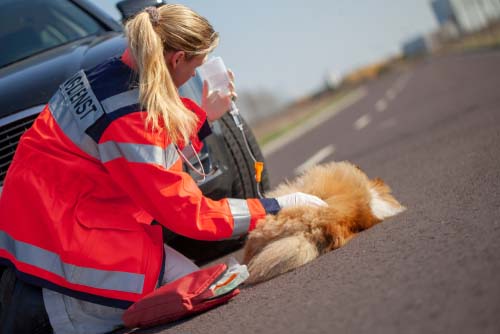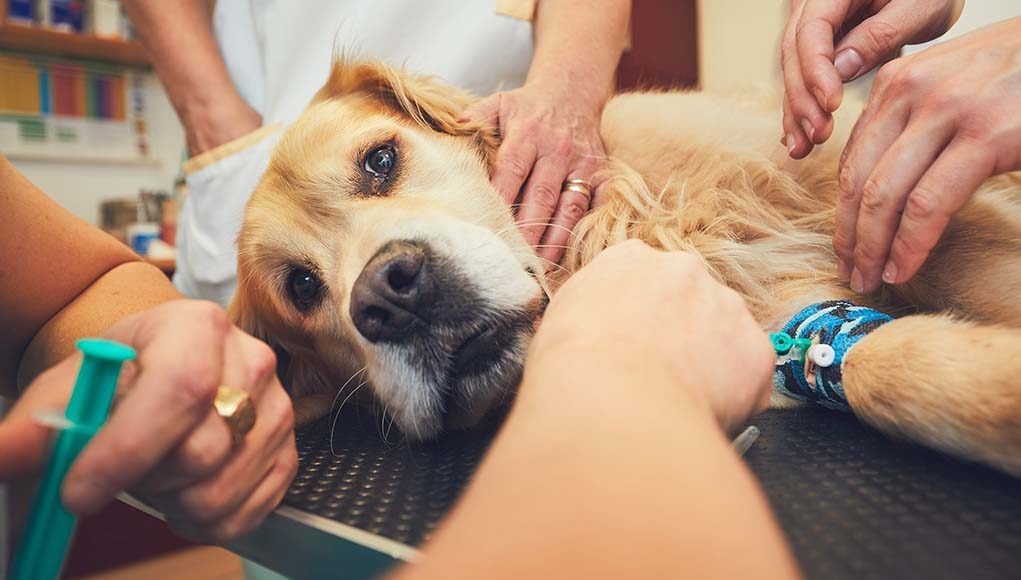Dealing with any type of dog health problems is often distressing for pet owners, and you must take your pup to the vet if you feel concerned about anything. However, there are some medical emergencies that require immediate attention. In some cases, you might even have to administer first aid for dogs before you take them to the vet.
Knowing what these emergency dog health problems are, and what to do about them can save your dog’s life. So make a note of these nine conditions mentioned below, and make sure you always have a pet first aid kit on hand in case you'll have to deal with them.
1. Toxin Exposure (Poisoning)
There are many foods and substances that can be toxic to dogs, which is why there's a large number of cases of dog poisoning every year. In particular, veterinarians see this most often during holidays because of dogs consuming toxic human foods that are easily accessible. Moreover, various other toxic household items, garden plants, grooming products, and human medications are some of the most common causes of dog poisoning.
Symptoms of toxin exposure or dog poisoning will vary depending on the type of toxin, as well as type and amount of exposure and how much your pooch consumed. It's one of the most common emergency dog health problems and the usual symptoms of poisoning include vomiting, diarrhea, loss of appetite and drooling.
What to Do:
Inform yourself about toxic substances so you can prevent exposure. Here you can see a more comprehensive list of toxic substances to dogs, according to The American Society for the Prevention of Cruelty to Animals. It's best to make a list of these, print it out and keep it in or near your pet first aid kit at home.
If your dog gets exposed to a toxic substance, treatment will depend on the type and amount of substance your dog ingested. Call your vet or poison control hotline immediately to get instructions: (888) 426-4435
Usually, you will be instructed to induce vomiting in the dog if the toxic substance was ingested. If your dog’s skin came into contact with the toxic substance, wash your dog off thoroughly.

2. Trauma/Injury
Trauma is considered to be any type of serious injury that happens to your dog and it's also one of the more common emergency dog health problems that vets often see. Major traumas that veterinarians deal with on a regular basis come from dogs getting in a dog fight, being hit by a car, falling from somewhere high up. There are also minor traumas in dogs, like tearing a toenail or getting cut on a sharp object.
Serious traumas and injuries can lead to shock, heavy bleeding wounds, broken bones, internal injuries and internal bleeding, head trauma and other serious dog health problems that require immediate attention to save the dog's life.
What to Do:
After any major trauma, you need to take your dog to emergency vet clinic right away. In some cases, you can deal with wounds along the way if your dog has external bleeding. To do that, gently put a clean cloth or gauze on the wound and press it moderately to stop the bleeding. You can also try to elevate the bleeding area if necessary. If the cloth or gauze becomes soaked with blood, replace it with another and keep the pressure on the wound until you get to your vet.
If you suspect that your dog has broken a bone, try to minimize movement in that particular area. Deal with any open wounds and bleeding, and take your dog to the vet right away.
3. Insect Stings and Bites
Although in most cases, insect stings and bites will not cause any serious dog health problems, some dogs can have a dangerous allergic reaction and require immediate veterinary care. This is usually a result of multiple stings or bites, while some dogs are just too sensitive. Depending on where you live, your dog may also have an encounter with venomous insects, like spiders, or scorpions, or even snakes.
If your dog exhibits severe pain by whining or yelping, if he has muscle spasms and/or tremors, difficulty breathing, drools excessively, has increased heart rate and swelling of the bitten area, it is possible that he was bitten or stung by a venomous insect or snake.
What to Do:
Regular insect bites or stings are fairly easy to deal with and there's a special procedure for that. Simply clear the bite area and remove the stinger if it is visible. If you notice a mild swelling, give your dog some diphenhydramine (plain Benadryl) to prevent an allergic reaction. You might want to check the dose with your vet first.
If the swelling becomes severe or you notice any hives on your dog’s body or any of the symptoms that might indicate that your dog was bitten by a snake or venomous insect, take him to the emergency vet clinic immediately.

4. Respiratory Distress and Choking
Dogs can experience breathing problems for many reasons and sometimes there can be no known cause. In most situations, respiratory related dog health problems are due to choking and your pup having swallowed something. Breathing problems are always an emergency, especially if your dog stops breathing.
Some of the common symptoms of respiratory distress in dogs include gasping for air and gagging, as well as blue, gray or purple gums.
What to Do:
If you notice that your dog is having breathing problems, try to open his mouth to see if there is some obstruction that causes it. If you see an object, try to remove it but be careful when you do it or you might get bitten or lodge it further into the dog's throat.
If you can’t remove the object, try to lift your dog off the ground and point his head down. If you have a very large dog, lift his back and elevate the abdomen. If this doesn’t work, you need to try another choking maneuver, like the Heimlich maneuver. If none of these options are available to you, it's time for an emergency vet visit.
5. Heat Stroke
Heat stroke is one of the most common dog health problems observed in summer months. If you notice symptoms of overheating like excessive panting, signs of discomfort or inability to move around, check your dog’s temperature immediately. Temperature over 104°F signals heat exhaustion, while temperature over 106°F is a heat stroke.
Heat stroke symptoms in dogs include drooling, diarrhea, vomiting, loss of consciousness and collapse, and can often be fatal.
What to Do:
Keep your dog out of hot temperatures to prevent heat stroke. During the hot summer days, walk your dog in the morning or in the evening when temperatures are lower. Provide plenty of fresh drinking water at all times and enough shade if your pooch spends his time outdoors. Use cooling vests or collars to keep your pooch cool during walks.
If you notice that your dog is already having a heat stroke, the first thing you need to do is cool him down. Get him to a cool and shady area, preferably with air conditioning or at least a fan. Use cool water to wet your dog down, but don’t use very cold or ice water since that can constrict the blood vessels and trap the heat in. Once your dog’s temperature is down to 103.5°F you should stop with cooling and take him to the vet to check if any internal damage occurred.

6. Seizures
Abnormal brain activity can lead to seizures, which always entail an altered state or even loss of consciousness in dogs. There are many different types of seizures and they can have as many causes, and lead to other dog health problems associated with more symptoms. They also range in severity. Serious seizures can last long and be very violent.
What to Do:
If your dog has a seizure that lasts less than a minute, it is probably nothing urgent but you should take him to the vet to check it out. If the seizure lasts more than a minute, if there's a total paralysis, then take your pooch to the vet immediately because there's nothing that you can do yourself to help the dog.
7. GDV/Bloat
This condition, known as gastric dilatation-volvulus or canine bloat, is very serious and one of the more life-threatening dog health problems. It occurs when a dog’s stomach expands and rotates, which leads to trapped gas inside the stomach. This cuts off blood supply to both the stomach and spleen. Large dogs with deep chests are particularly at risk of canine bloat.
Common symptoms include bloated abdomen, heaving, retching, excessive salivation, lethargy and heavy panting. If you notice some of these symptoms, check out your dog’s gums. Pale gums are also a sign of GDV.
What to Do:
Bloat is a life-threatening emergency and the only thing you can do about it is take your dog to the vet instantly. Do not attempt to deal with bloat in dogs yourself, as time is of vital importance. At the vet, surgery will be necessary and this condition has a survival rate of 80%.
8. Collapse
There are many different dog health problems that may cause pets to collapse, including low blood sugar, heat stroke or heart disease. Whatever the cause is, collapse is a serious condition and requires immediate veterinary care.
What to Do:
Don’t approach your dog before you make sure that it is safe. You may get bitten if you put your hands near his mouth while he is having a fit. Try to remain as calm as you can and reassure the dog. In some cases, a small amount of food can help dogs recover.
Take your dog to the vet after letting him rest for a bit to determine the cause of the collapse or take him right away if the symptoms persevere for more than 10 minutes.

9. Sudden Cardiac Arrest
The most obvious and deadly of emergency dog health problems is heart related. Sudden cardiac arrest means that the dog's heart has stopped pumping. When this happens, a dog will collapse, lose consciousness and eventually stop breathing.
What to Do:
First you need to evaluate your dog’s condition. Hold the back of your hand up to his nose to check if he is breathing. You can also look at his chest. If your dog is not breathing, check his airway for any blockage and remove it if there is (see choking tips above).
Check your dog’s pulse next or put your ear on his chest to try to hear and check the heartbeat. If you can’t find the pulse, it is likely that your dog suffered a sudden cardiac arrest. Unfortunately, in most cases, sudden cardiac arrest is fatal. However, you can potentially save your dog’s life with dog CPR (cardiopulmonary resuscitation).
CPR performed by a professional will give your dog the best chance to survive but that is usually not possible when sudden cardiac arrest occurs.
The most important thing with any emergency dog health problems is to remain calm. When your dog suffers a medical emergency, your appropriate and swift reaction can often save his life, especially in case of these nine above mentioned dog health problems where every second is valuable.
READ NEXT: 7 Most Common Health Problems of Senior Dogs













